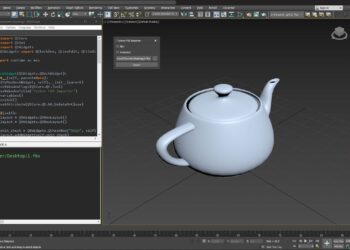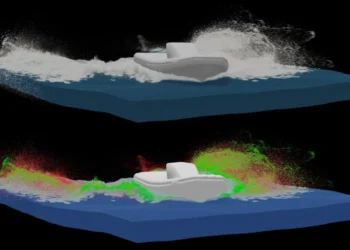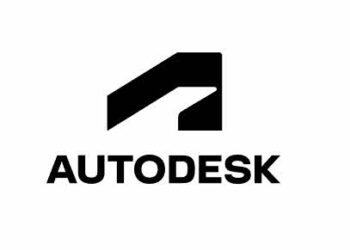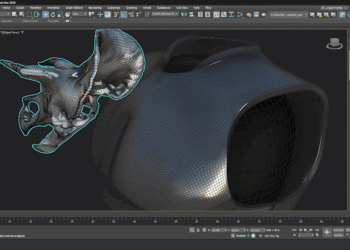Around the year 2000 Autodesk embarked on a rewrite of 3D Studio Max. At the time rumors abounded, but official information was scarce. A few years later, however, development took a different direction and Nitrous was left behind. Since everything was kept under NDA no official explanation was given and many of us were left with question marks. Some weeks ago, Autodesk representatives referred to the rewrite publicly for the first time, and shared some information on the subject, mentioning that the NDA signed by beta testers had termed out. In order to find out what happened, and trace one more part of 3D Studio Max’s history (after the departure of the Yost Group from Autodesk), we have put together some pieces of the puzzle with the great help of two Max users who were beta testers at the time: Borislav “Bobo” Petrov and Kees Rijnen.
Update: in September 2010 we have incorporated a special contribution by Fred Ruff, who was product designer of Nitrous at Autodesk, and has shared a first-hand account of his experiences during the Nitrous project.
Some of the content below was extracted from messages on CGTalk, while Fred Ruff and Bobo have added lots of information that was previously unavailable to the public. We would like to thank Borislav “Bobo” Petrov, Kees Rijnen and Fred Ruff for their generous contributions, as well as CGSociety for authorizing the reproduction of part of the content on these pages and helping more readers have access to them.
Index:
Part I: Kees Rijnen
Part II: Borislav “Bobo” Petrov
Part III: Fred Ruff
Readers’ comments
Kees Rijnen
Regarding Nitrous,
The once in-development potential replacement of 3dsMax.
(This was before Maya and XSI were bought by Autodesk)
(…)
Although I loved the idea of a new application, removing all the core problems from 3dsMax, I never really liked where Nitrous was going.
It had some really good things about it (I’m not sure if we can point out what was good about specifically), like Ken said, one specific thing it did with animation was really kick-ass.
The real-time viewport was also nice and C# was at its core, which made plugin development stupidly easy. I made a Nitrous plugin well before I ever made a 3dsMax one
Though I would think the C# thing would not help with the multi-platform talks I hear here.
The underlying node-based stuff was beautiful though. Although the UI wasn’t the greatest at the time.
But there were some things very wrong with Nitrous (imo) that I don’t think I would have picked it if I had to leave 3dsMax behind. I would have likely switch to XSI, possibly Maya.
The worst thing about it, if I had to pick one thing, was how the project was being handled though. Autodesk was constantly trying to push Nitrous into different markets.
I.e. one day it was the replacement of 3dsMax (potentially exciting!)
The other day it suddenly was a ‘bring all your stuff of all apps together into Nitrous and do your final layout there etc).
Then suddenly it became a ‘core’ to which you build your own tools on.
(Good luck selling that to programmers in a game company who prefer to write their own cores really)
It was just clear Autodesk had no clue where to go with these things.
Instead of ‘buckling down’ and trying to make it a complete 3D package that had most features 3dsMax/Maya had, I think they were afraid of that amount of work and instead were trying to get us to commit to using Nitrous well before it was ever a usable 3d package.
As a 3dsMax user at the time, I was super excited about getting a new app and was willing to look passed a lot of the issues. But none of the non-3dsMax users at the company I worked for were impressed at all by what they saw of Nitrous. (The demos they gave us were also super not impressive, even though I knew it could do a LOT more because I could actually use it)
I more than once heard the comment: “Well if we are going to consider switching away from 3dsMax, we should also consider <maya/xsi/etc>.
And those guys were totally right. What Autodesk showed us of Nitrous was really not suitable to be used in production yet. It had a ton of solid, basic stuff (and incredible amount of cool nodes) but it wasn’t ready as a complete tool yet.
…and then Autodesk gave up.
A shame, because I think had they spent a little while longer on it, it could have become really good, but it really failed because Autodesk failed to push it in the direction of being a complete 3D package and suddenly tried to make up new business models for the thing.
In the end, my conclusion (when I was asked by somebody of Autodesk on the project) was that at this stage I would prefer them to fix the issues in 3dsMax instead. Mainly because it felt like Nitrous was no longer on track of becoming a complete 3d package. And to be honest, that’s all I wanted it to be. I didn’t need another application dropped in the pipeline that we didn’t really ask for in the first place.
Borislav Petrov
In my opinion, understanding what Nitrous was and wasn’t is very important to understand why the XBR initiative is such a Good Thing. In short, Nitrous provided an opportunity for the 3ds Max developers to try to write a completely redesigned core and find out what works and what doesn’t without ANY legacy and compatibility considerations to limit them. Many people were surprised when more information about XBR leaked, as there have been rumours about a complete rewrite for nearly 10 years. The answer from Autodesk was also surprising for many: “Well, we tried that and it didn’t work out”. The good news is that knowing what doesn’t work is half the battle when you want to create something that does.
Toxik almost died the same early development death but then somehow managed to survive the process. It is the living proof of what would have happened to a Max successor (but it would have been worse). Nitrous LOOKED very much like Toxik 1.0, down to the node editor and even the color scheme…
Some people were under the impression that Nitrous was somehow based on Toxik code, but as far as I know that was just on the surface. It was an attempt to unify the look of “Discreet” products, inspired by the high-end systems.
There were some very Maya-esque things about Nitrous that I did not necessarily like and I am sure they won’t make it over to Max this time around. In fact, Nitrous nearly killed the modifier stack.
While there was something similar to a Modifier Stack in some early builds, the way history was handled was similar to Maya and Softimage’s systems. Lots of nodes, one for each small change, were created and required eventual manual or automatic collapsing. On the positive side, the handling of many thousands of nodes was so fast it didn’t really affect performance, but we all know the Modifier Stack is a genius concept that goes beyond automatic modeling history. Without a Modifier Stack it is not Max anymore. And Nitrous didn’t feel like Max to me.
Remember that the project was started almost 10 years ago which is almost an eternity in the world of 3D. When Nitrous was designed, 3ds Max was just beyond version 4, and Autodesk did not have the benefit of “hosting” the development teams of Maya, Softimage and Mudbox with all their technological insight. So I am quite sure that many aspects of that project are not relevant anymore.
But there were some components of the system that have either made it into 3ds Max already, are about to be added or are officially part of the XBR plans.
As I mentioned, Nitrous was very different from Max and not at all compatible with it.
The general plan was to run Max and Nitrous side by side for a while, with Max serving as the basic modeling and animation package, and Nitrous as an “assembly stage” since it was able to deal with potentially billions of polygons using various techniques I cannot talk about (and it was 32 bit!)
So nobody expected it to replace Max immediately, but to serve as a hub, kind of like Lightwave’s Layout on steroids to put stuff together and send it off to rendering.
During the development process, it became clear that the core was quite solid despite being written completely in C# which is notoriously tricky to get the best performance from due to its automatic memory management. But it would have taken a lot of years and manpower to add all the tools that were already in 3ds Max. Granted, there were a lot of prototypes of useful tools that went farther than their 3ds Max counterparts or were better integrated. For example a Rigid Body Dynamics prototype based on the same Havok libraries that Max used were completely real time and fun to play with. Viewports were unlimited in count and placement. Scene data management was quite smart and provided some very cool background caching.
But then features started disappearing and we heard of plans to provide a bare-bone version just for scene assembly and another one as a kind of SDK core to build other applications around it, possibly even for free (curious fact – the code name of that second flavour actually survived within Autodesk and was used for a completely different component of another package). As Kees mentioned, these ideas did not sound very exciting to someone expecting a better 3ds Max future. In short, management was trying to pull a Modo – develop a small core application that can do very few things very well, and then grow it over many years until it turns into a full package. For me, this was a very good approach to alienate a large part of the existing user base and drive it in the hands of the competition. Imagine many years of having no significant improvements in the old system (3ds Max) while waiting for the new one to catch up in features. Even to this day, Toxik/Composite does not provide everything Combustion had to offer. And while XSI nearly pulled it off by producing a competent package in the end, it still lost most of the Softimage 3D user base to Maya in the process and could never fully recover.
As far as I know, there were no plans for native .MAX file support (mostly because it is simply not possible), and we tested it by moving data using (I kid you not!) the Max ASCII exporter (ASE). A better format could have emerged eventually, but that was one of the biggest issues I had with it. That, and the fact it was generally planned not to ship with a renderer except for the hardware rendering in the viewports.
Can you imagine 3ds Max with just Quicksilver as the only renderer? Me neither.
To be fair, I have seen a Nitrous demo with mental ray integration and it was working without problems, but the product management wanted to provide just an interface for 3rd parties to deal with rendering, but no default software renderer.
The shading and materials pipeline wasn’t even touched during the development except for a couple of DX shaders for the viewports.
The coolest aspect of the viewport graphics was the shadow casting and it took several years until 3ds Max 2008 got the same ability, but the benefit of the Nitrous experience made the Max implementation much better in my humble opinion.
Max 2010’s viewports already kick Nitrous’ behind in terms of quality of lighting, shadows and shaders. They just need an update for performance and flexibility.
Judging by the XBR slides that were made public last year, Max is getting some of the things that were good about Nitrous, while preserving most of the existing tools and workflows we are so dependent on and would have missed in a new package.
Thus, having seen some of what Nitrous could have been, I can hardly wait to see what XBR will be.
Fred Ruff
I was the product designer of nitrous for 5 years before it was killed. When it died, a little of me died too. If you love sausages or 3D software, you should never visit a sausage factory or a software company.
(…)
Nitrous was really a dream come true for me. I started in 3d with 3d studio DOS. Me and Frank Delise went to the same college together and 3d studio is how we met.
I started working on Nitrous just after 3ds Max 4. One of the main problems was Autodesk kept switching upper management. After several “re-structurings” people forgot what we were really doing with Nitrous and how far we had come.
Re-writing a tool like 3ds max is a huge responsibility. We wanted to get the core of it right. Viewports, Interface, Bitmaps all while keeping the speed up. We didn’t have a product manager in the beginning fight for us since there was no features to be a product. Once we got the core up and running, management couldn’t decide what to make from it. We all wanted a new 3ds max, but the list of modeling, animation and render features was huge by that point. Some people suggested we skip making features and ship some kind of “engine” for people, but all the real max users at Autodesk knew that wouldn’t sell. Everyone had their own ideas for nitrous and that made it even more vulnerable. Myself included wanted to go after the game industry with a tool built specifically for making game assets.( normal map creation, mesh sculpting, Realtime shaders, etc.) In the end, we all saw it coming. Special thanks to Jeff Yates for saving the team, and convincing Autodesk to take them away from the Discreet division and use them as a core team for Autodesk headquarters.
Nitrous was a real learning experience as was Autodesk. I’m so glad that max is going so strong in 2010! I’ve learned that tools are just that. A tool, and if you can make cool stuff with it, great. Don’t hold your breath for features, cause many of the people in charge at large corporations have never used the product that they are in charge of. Thank God for plugins- that’s where the real cutting edge stuff happens.
— posts end here —
Autodesk has disclosed that some ideas and technologies developed for Nitrous are now being used in Excalibur, the under-the-hood rewrite of Max that is taking place in various phases. Getting to know the history behind Nitrous and its outcome helps one better understand the current XBR rewrite and its focused approach.
We would like to thank Autodesk for helping us confirm the accuracy of part of the information presented in this article.









It seems this article stroke a chord with Lightwave users, who are finding Lightwave Core’s development bears certain similarities to Nitrous’s.
Newtek forums
http://www.newtek.com/forums/showthread.php?t=109109
Luxology forums
http://forums.luxology.com/discussion/topic.aspx?id=46598
Too bad that Autodesk could not push it forward decently. 3DS MAX and Maya could really use a total rewrite. Hhh, just dunno what package is future-proofed these days. Softimage ? Modo ? Blender ?
Thanks for this Great article. To hear it from two Max Gods even better!
I was so happy to read Bobo’s comment “Without a Modifier Stack it is not Max anymore”
Okay stupid question time: Sure max’s core is old but architecture wise, whats wrong with it? Is there something fundamental wrong with the design or is it just old?
There are several fundamental problems with the way some Max core elements were designed back in the early 90s.
The biggest points:
*Event Notification system – in early Max, changes would propagate through all dependencies, sometimes multiple times, and often cause an avalanche of updates. This was addressed partially between Max 6 and Max 8 and made animation rigs a lot faster – by no coincident around the time Nitrous was still being developed and tested. Nitrous’ update system was insanely better and designed with performance in mind.
*Multi-threading – Max was designed in days of singe CPUs and it was still made somewhat accelerated on multi-core systems. Each viewport had its own thread and the Scanline renderer could shade multiple scanlines on multiple CPUs. But when it comes to evaluating scene objects and their modifier stacks, there is no parallelism concept whatsoever in the core design. Even when PFlow was added in Max 6, it was designed for single-threaded evaluation. This has to change sooner or later because my $2K gaming machine at home already has 8 cores and more are coming.
*GPU acceleration – nobody expected that technology to emerge when Max was initially designed. A lot of work is going into this through the XBR initiative, not only for viewport shading, but possibly in other areas that could use parallel processing.
*Managed Code / DotNet / C# integration – while people are skeptical about that portion of Max (see: Scene Explorer, Ribbon), Nitrous was entirely written in C# and showed the developers how easy it would be to extend the UI and tools using C# and DotNet controls instead of messing with the (ancient) Win32 libraries.
@Othoap: Glad you liked the article. We have to thank Kees and Bobo for sharing all this great info, and helping give some answers to pending questions that have been floating around for years. There was little to no info available on the web on this matter before their posts.
It’s been a while since the Nitrous rewrite. While preparing the article I was wondering how many ppl who started using Max in the past few years had actually heard of the rewrite project.
Lord Bobo, Thanks for your replay.
Very interesting, I suspect Nitrous was like a concept car. It will never see production but many lessons were learned.
Great to here GPU is part of XBR. We’ve had many hardware promises down the years but none like multi-core GPU. CS4 on a SLI machine is by far the biggest performance boost I’ve seen. As Charles P. Thacker said the future is in parallel processing.
What if every three years we dump our old hardware, OS and apps. No legacy to tie us down and upgrade to all new. Sure it would be big $$$$ but imagine the advancements. la,la,la
Pablo,
GREAT article ! Yes thanks to Kees and Bobo. WOW to read it in there own words, it’s like standing on the grassy knoll.
I for one didn’t know JACK of a rewrite, so thanks MU. I do understand the complexity’s of a job like that. But with people like Kees and Bobo at the helm I know the ship would be safe, just look at krakatoa and ShaderFX for proof.
I would think the big challenge is the politics of scuttling the old and launching the new. Many people could be upset to say the least. I’ve worked for big companies and gave up trying to understand why they do the things they do. My trust is in the engineers and user base.
Good read. It is pretty interesting to say the least, thanks.
Very interesting!!! Congrats.
Thanks for the interesting information.
3dsMAX remains, and it is good.
Thanks for all the comments. Great to hear you’re finding the article interesting.
@Othoap: Regarding big company policies, there’s a great film called The Corporation that offers an in-depth psychological examination of big companies and corporations and how they behave. It’s very funny and sheds a lot of light into how such organizations work. Definitely worth checking out:
http://www.imdb.com/title/tt0379225/
Ha, interesting article. Very insightful. 🙂 Bobo and Kees did have a good deal of insider information at the time.
>>one specific thing it did with animation was really kick-ass<<
Ahh, those were the days.
Nitrous certainly did have a lot of potential, along with a lack of clear direction and poor timing. Ultimately Nitrous as a product did get dropped, but a lot of the research and technology behind Nitrous has steadily been migrating into many applications in Autodesk.
Fascinating article, lets just hope autodesk gets it right with the current development path!
Cheers,
Dave
My name is Fred Ruff. I was the product designer of nitrous for 5 years before it was killed. When it died, a little of me died too. If you love sausages or 3D software, you should never visit a sausage factory or a software company. For any of you that wanted the next generation of max, I’m sorry,
I did my best.
Fred
Hi Fred, is there anything else you can add to the article without breaking any NDA stuff?
Dave
Nitrous was really a dream come true for me. I started in 3d with 3d studio DOS. Me and Frank Delise went to the same college together and 3d studio is how we met.
I started working on Nitrous just after 3ds Max 4. One of the main problems was Autodesk kept switching upper management. After several “re-structurings” people forgot what we were really doing with Nitrous and how far we had come.
Re-writing a tool like 3ds max is a huge responsibility. We wanted to get the core of it right. Viewports, Interface, Bitmaps all while keeping the speed up. We didn’t have a product manager in the begining fight for us since there was no features to be a product. Once we got the core up and running, management couldn’t decide what to make from it. We all wanted a new 3ds max, but the list of modeling, animation and render features was huge by that point. Some people suggested we skip making features and ship some kind of “engine” for people, but all the real max users at Autodesk knew that wouldn’t sell. Everyone had their own ideas for nitrous and that made it even more vulnerable. Myself included wanted to go after the game industry with a tool built specifically for making game assets.( normal map creation, mesh sculpting, Realtime shaders, sct.) In the end, we all saw it coming. Special thanks to Jeff Yates for saving the team, and convincing Autodesk to take them away from the Discreet division and use them as a core team for Autodesk headquarters.
Nitrous was a real learning experience as was Autodesk. I’m so glad that max is going so strong in 2010! I’ve learned that tools are just that. A tool, and if you can make cool stuff with it, great. Don’t hold your breath for features, cause many of the people in charge at large corporations have never used the product that they are in charge of. Thank God for plugins- that’s where the real cutting edge stuff happens.
Fred
Thanks for your insight Fred!
It adds a lot to what’s already been posted, especially coming from one of the core people.
Dave
Great article, thank you guys.
>> Don’t hold your breath for features, cause many of the people in
>> charge at large corporations have never used the product that they
>> are in charge of.
Such a sad truth, thanks for sharing Fred. Maybe one day the 3d software industry will go through a rebirth and it can be as vital and exciting again as it was so many years ago.
– Neil
Hello Fred,
this is a sad story. Even from a user viewpoint someone can realize those issues. The major improvements in the last few max versions seemed to be mainly because Autodesk acquired plug-ins. The inhouse development look a little strange. Someone could really imagine a developer having endless discussion with executives ending up with something that looks good in power-point presentations for people who never will use the software(viewcubes
ect.) What for a waste of talent. I only worked for small companies, but executives often seemed to be ensnared by there own streamlined business talk. But probably this is capitalist logic, when executive not necessarily have to have any passion for what say actually want to sell. So it is astonishing that some of the brilliance of the developers still find it’s way into the final product.
(sorry for the poor english)